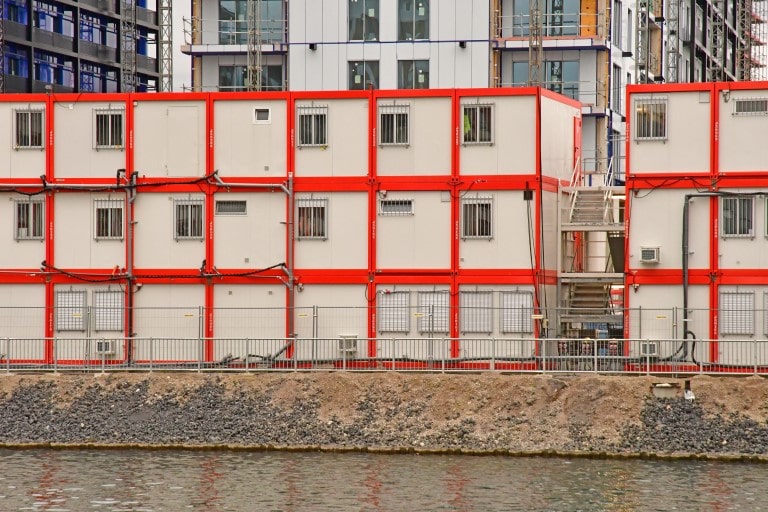Not only are shipping containers are a great way to transport valuable goods across oceans and seas, and even by air if the consignments are not inordinately massive, but many government agencies and rescue & relief organisations also use shipping containers during disasters. We take a look at how shipping containers have been used in disaster management and just why they are so indispensable.
Uses of shipping containers in recent natural disasters
- Hurricanes, snowstorms and tornadoes used to be occasional natural disasters just a few decades ago. With rapid climate change, these calamities are manifesting with greater frequency. To deal with such recurring eventualities, cities like Brooklyn are experimenting with multi-storey emergency housing facilities made of shipping containers to combat disasters like Hurricane Sandy in 2012. Three and four-story post-disaster housing complexes have been set up complete with furniture and a cooking space, as well as bathing, living and sleeping areas.
- The entire world was witness (thanks to News reports and YouTube videos) to the Tōhoku earthquake near Japan and the subsequent tsunami that wreaked havoc of unprecedented proportions in 2011. In response to the massive disaster, the Japanese architect Yasutaka Yoshimara created a series of shipping container shelters under the project titled “Ex Container Project”. These shelters proved to be low-cost as well as high-quality. Many 20-foot by 20-foot containers were joined together to create kitchens, living and sleeping areas.
- More than 181 people were killed in the Christchurch earthquake of February 22, 2011, rendering thousands of people homeless. In the wake of the earthquake shipping containers were used as shelters to construct barriers around the houses that had been destroyed and to protect vehicles and pedestrians from falling rocks and debris originating from damaged buildings and houses.
- Similarly shipping containers have been used in the wake of the 2010 Haiti earthquake that razed almost the entire country.
Why use shipping containers during disasters?

Shipping containers are ideal when it comes to creating temporary shelters, hospitals, ablution blocks and any other facilities required in a disaster situation. They are durable and they can withstand jolts and crushing pressures – even when cargo ships sink, shipping containers can remain undamaged under the harshest oceans for many years. This makes them perfect candidates for disaster-hit locations.
Shipping containers are designed to bear lots of weight, typically more than 60,000 lbs each and they can easily withstand 150 mph winds. If sheltering objects or people in a shipping container there is less chance of damage or death if heavy debris, such as trees, fall on a stationary shipping container. At the most, it will get some dents. A shipping container cannot be broken easily.
Above all, they are totally environment friendly. Instead of turning into rust in some dump yard, if they are used during disaster management, lots of construction material that would otherwise be required can be saved.
What natural disasters can shipping containers be used for?
.jpg)
Whether solid shelter against the onslaught of a hurricane or post-disaster housing is needed, people can rely on the strength of the humble shipping container. Using shipping containers as shelters during disasters are ideal for parts of the world where rescue materials and shelter equipment are not readily available.
Shipping containers can be used during the following disasters although their usage isn’t just limited to these natural disasters:
- Tornadoes
- Hurricanes
- Tsunami
- Earthquakes
- Snowstorms
- Floods
- Animal attacks
- Famines
- Epidemics
What is the advantage of using shipping containers compared to other materials?

Their size and sturdiness are of course very big pluses. But the greatest advantage of using shipping containers during man-made as well as natural disasters is that they can be easily transported to the affected areas. They come in different sizes and shapes, they can be loaded and unloaded with maximum speed and little inconvenience, and they can be disassembled and assembled without much difficulty. Shipping containers can be stacked on top of each other during transportation – this way you can transport multiple shipping containers in a single truck or any other vehicle being used in the disaster management operation.
Standard shipping containers come in either 20 foot or 40 foot sizes and can be flown by a plane, sailed by a large ship, driven on trucks and sent by trains. You can also transport shipping containers using helicopters and drop them at precise locations.
What disaster management facilities can shipping containers provide?
With the help of shipping containers you can create:
- Medical emergency rooms and operating areas
- Temporary housing for the victims of the disaster
- Kitchens and canteens to cook and distribute food items
- Planning rooms for the officials to hold meetings and take critical decisions
- Contamination containment units
- Storage facilities
Both standard and modified shipping containers can be used at the times of disaster. It depends on the availability. Many organisations involved in disaster management activities promote the idea that shipping containers be used to reduce costs, as well as to hasten the transport of goods and temporary shelter to the affected areas. Since thousands of containers are constantly on the move all over the country and all over the region, it is easier to access shipping containers that are nearby rather than bringing them from their respective production houses.
Need multi-storied post-disaster housing?
Using shipping containers as temporary housing facilities makes perfect sense because they already have a modular structure that is as solid as any small-sized house. They can also be built within days, if not hours. When it comes to using shipping containers during disaster management operations, their utilisation is is only limited by your imagination. Even bunkers are being constructed out of shipping containers to meet apocalyptic eventualities like a zombie outbreak (well, who knows?) or a nuclear holocaust. Contact our team of second hand shipping container experts at Gateway Container Sales and Hire for advice on which container will best suit your needs.




